Cross Cultural Management: Hydro Generation Project Analysis
VerifiedAdded on 2023/06/15
|9
|2533
|323
Report
AI Summary
This report analyzes the cross-cultural management strategies employed by Brett Jones in Hydro Generation's Tanzania project. It highlights the importance of organizational culture, including alignment, appreciation, and trust, in achieving business success in a foreign environment. The report discusses challenges such as nepotism and religious culture differences, offering recommendations for developing effective strategies to overcome these issues. An individual reflective report is included, discussing the application of organizational structure theories and the importance of adapting to cultural differences. The report concludes that adapting organizational culture to the local context is crucial for effective business operations, emphasizing the need for structured and systematic approaches to resource utilization. The analysis emphasizes the significance of communication, teamwork, and continuous improvement in group tasks, drawing on Tuckman's theory of group development and Gibbs' learning cycle.
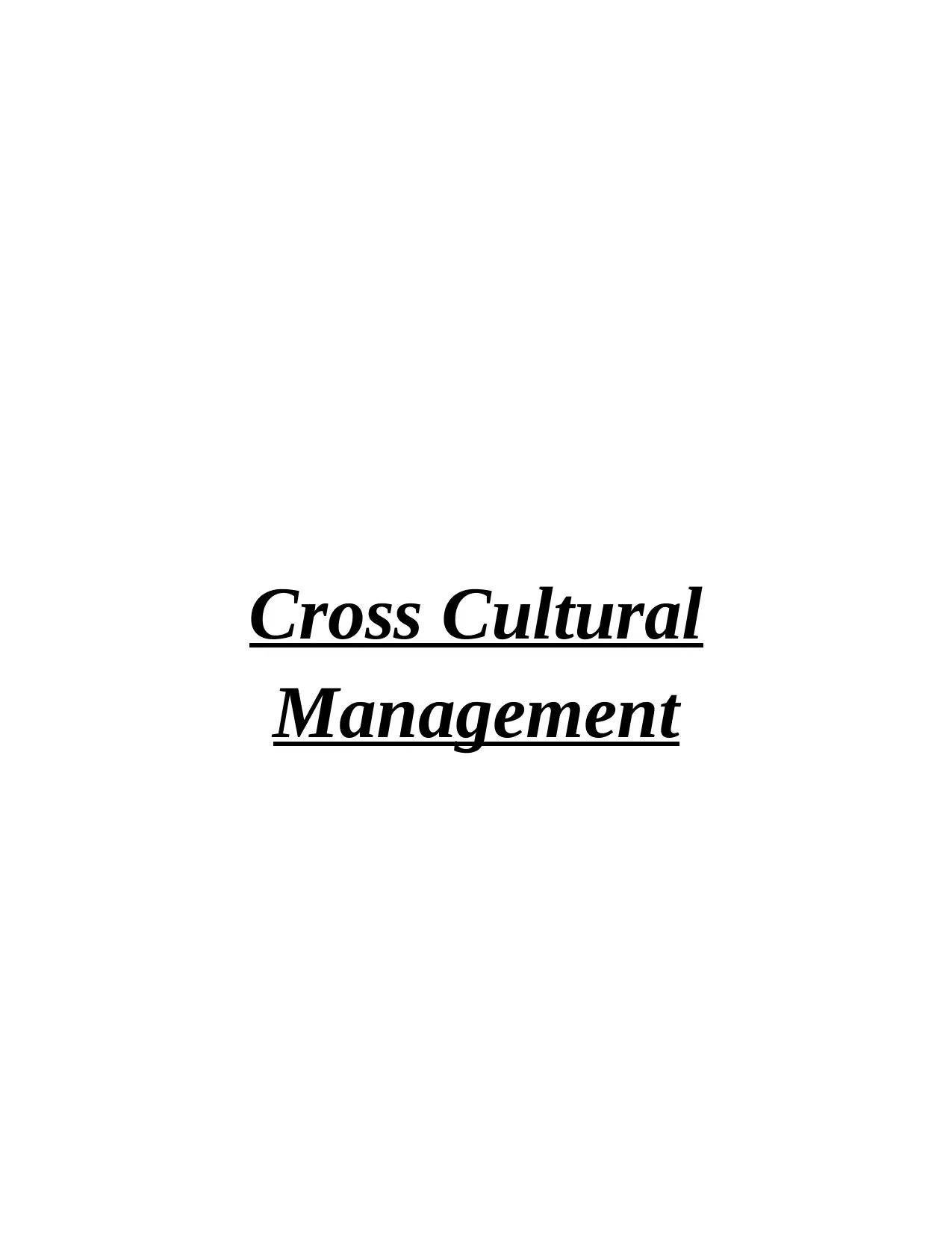
Cross Cultural
Management
Management
Paraphrase This Document
Need a fresh take? Get an instant paraphrase of this document with our AI Paraphraser
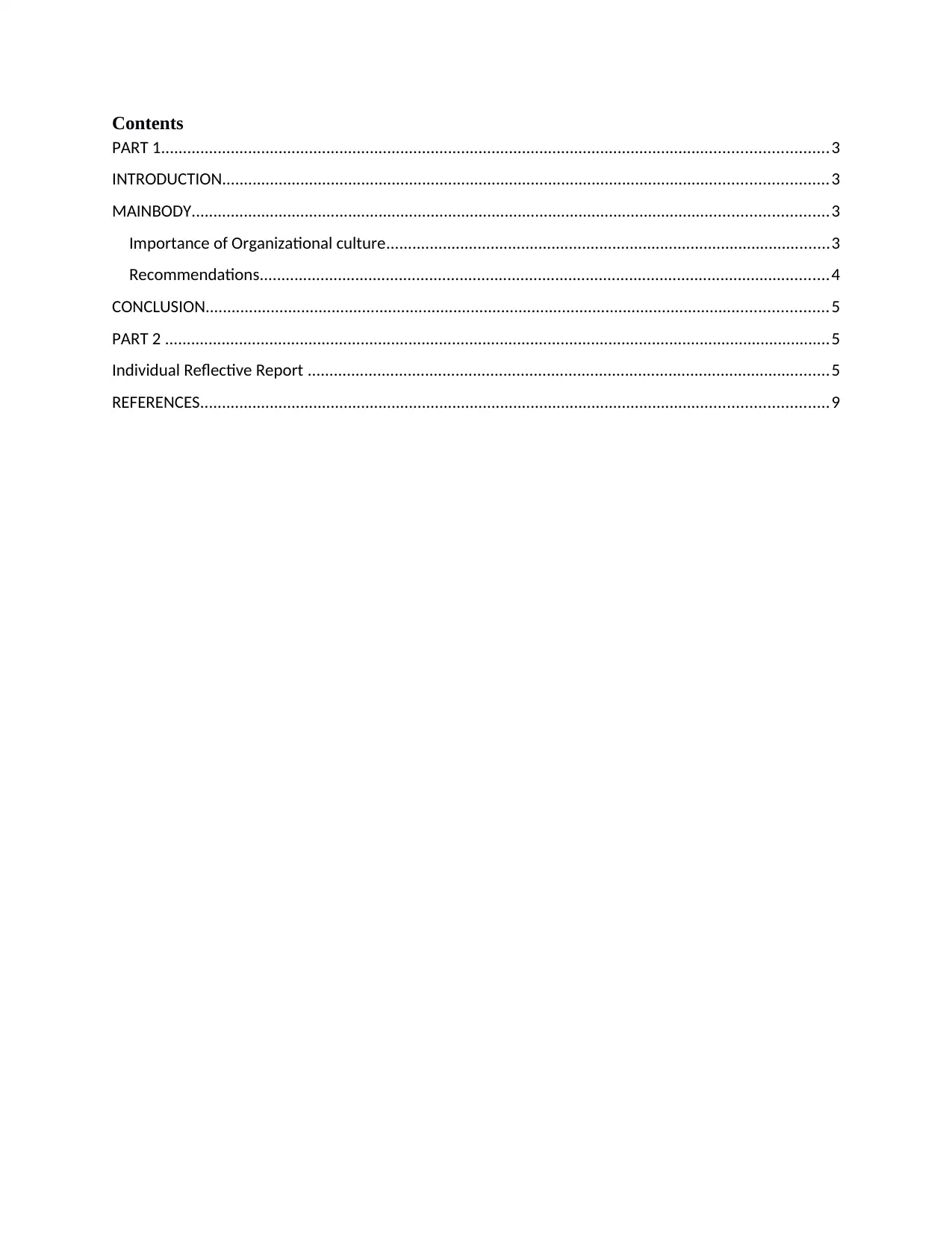
Contents
PART 1.........................................................................................................................................................3
INTRODUCTION...........................................................................................................................................3
MAINBODY..................................................................................................................................................3
Importance of Organizational culture......................................................................................................3
Recommendations...................................................................................................................................4
CONCLUSION...............................................................................................................................................5
PART 2 .........................................................................................................................................................5
Individual Reflective Report ........................................................................................................................5
REFERENCES................................................................................................................................................9
PART 1.........................................................................................................................................................3
INTRODUCTION...........................................................................................................................................3
MAINBODY..................................................................................................................................................3
Importance of Organizational culture......................................................................................................3
Recommendations...................................................................................................................................4
CONCLUSION...............................................................................................................................................5
PART 2 .........................................................................................................................................................5
Individual Reflective Report ........................................................................................................................5
REFERENCES................................................................................................................................................9
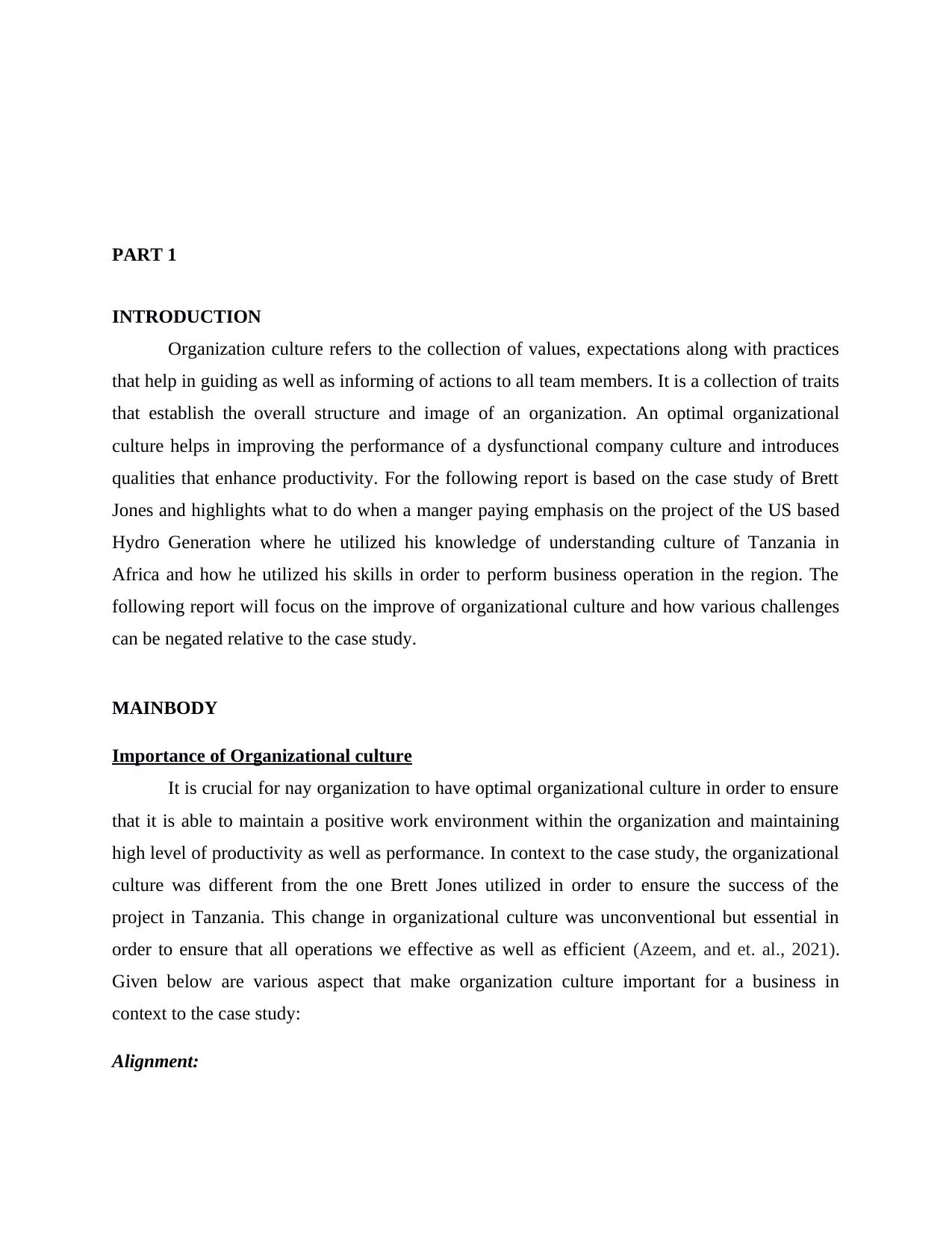
PART 1
INTRODUCTION
Organization culture refers to the collection of values, expectations along with practices
that help in guiding as well as informing of actions to all team members. It is a collection of traits
that establish the overall structure and image of an organization. An optimal organizational
culture helps in improving the performance of a dysfunctional company culture and introduces
qualities that enhance productivity. For the following report is based on the case study of Brett
Jones and highlights what to do when a manger paying emphasis on the project of the US based
Hydro Generation where he utilized his knowledge of understanding culture of Tanzania in
Africa and how he utilized his skills in order to perform business operation in the region. The
following report will focus on the improve of organizational culture and how various challenges
can be negated relative to the case study.
MAINBODY
Importance of Organizational culture
It is crucial for nay organization to have optimal organizational culture in order to ensure
that it is able to maintain a positive work environment within the organization and maintaining
high level of productivity as well as performance. In context to the case study, the organizational
culture was different from the one Brett Jones utilized in order to ensure the success of the
project in Tanzania. This change in organizational culture was unconventional but essential in
order to ensure that all operations we effective as well as efficient (Azeem, and et. al., 2021).
Given below are various aspect that make organization culture important for a business in
context to the case study:
Alignment:
INTRODUCTION
Organization culture refers to the collection of values, expectations along with practices
that help in guiding as well as informing of actions to all team members. It is a collection of traits
that establish the overall structure and image of an organization. An optimal organizational
culture helps in improving the performance of a dysfunctional company culture and introduces
qualities that enhance productivity. For the following report is based on the case study of Brett
Jones and highlights what to do when a manger paying emphasis on the project of the US based
Hydro Generation where he utilized his knowledge of understanding culture of Tanzania in
Africa and how he utilized his skills in order to perform business operation in the region. The
following report will focus on the improve of organizational culture and how various challenges
can be negated relative to the case study.
MAINBODY
Importance of Organizational culture
It is crucial for nay organization to have optimal organizational culture in order to ensure
that it is able to maintain a positive work environment within the organization and maintaining
high level of productivity as well as performance. In context to the case study, the organizational
culture was different from the one Brett Jones utilized in order to ensure the success of the
project in Tanzania. This change in organizational culture was unconventional but essential in
order to ensure that all operations we effective as well as efficient (Azeem, and et. al., 2021).
Given below are various aspect that make organization culture important for a business in
context to the case study:
Alignment:
⊘ This is a preview!⊘
Do you want full access?
Subscribe today to unlock all pages.

Trusted by 1+ million students worldwide
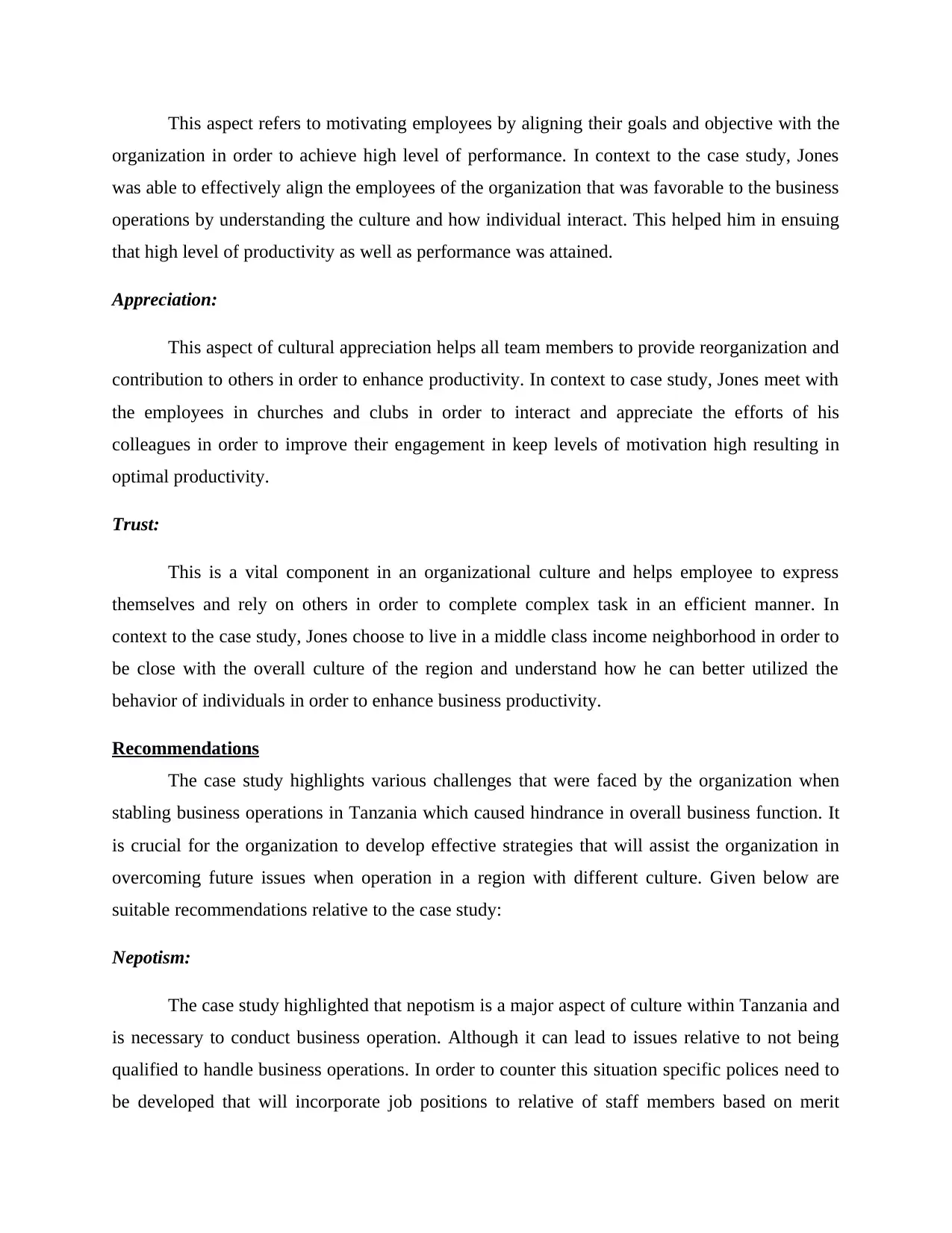
This aspect refers to motivating employees by aligning their goals and objective with the
organization in order to achieve high level of performance. In context to the case study, Jones
was able to effectively align the employees of the organization that was favorable to the business
operations by understanding the culture and how individual interact. This helped him in ensuing
that high level of productivity as well as performance was attained.
Appreciation:
This aspect of cultural appreciation helps all team members to provide reorganization and
contribution to others in order to enhance productivity. In context to case study, Jones meet with
the employees in churches and clubs in order to interact and appreciate the efforts of his
colleagues in order to improve their engagement in keep levels of motivation high resulting in
optimal productivity.
Trust:
This is a vital component in an organizational culture and helps employee to express
themselves and rely on others in order to complete complex task in an efficient manner. In
context to the case study, Jones choose to live in a middle class income neighborhood in order to
be close with the overall culture of the region and understand how he can better utilized the
behavior of individuals in order to enhance business productivity.
Recommendations
The case study highlights various challenges that were faced by the organization when
stabling business operations in Tanzania which caused hindrance in overall business function. It
is crucial for the organization to develop effective strategies that will assist the organization in
overcoming future issues when operation in a region with different culture. Given below are
suitable recommendations relative to the case study:
Nepotism:
The case study highlighted that nepotism is a major aspect of culture within Tanzania and
is necessary to conduct business operation. Although it can lead to issues relative to not being
qualified to handle business operations. In order to counter this situation specific polices need to
be developed that will incorporate job positions to relative of staff members based on merit
organization in order to achieve high level of performance. In context to the case study, Jones
was able to effectively align the employees of the organization that was favorable to the business
operations by understanding the culture and how individual interact. This helped him in ensuing
that high level of productivity as well as performance was attained.
Appreciation:
This aspect of cultural appreciation helps all team members to provide reorganization and
contribution to others in order to enhance productivity. In context to case study, Jones meet with
the employees in churches and clubs in order to interact and appreciate the efforts of his
colleagues in order to improve their engagement in keep levels of motivation high resulting in
optimal productivity.
Trust:
This is a vital component in an organizational culture and helps employee to express
themselves and rely on others in order to complete complex task in an efficient manner. In
context to the case study, Jones choose to live in a middle class income neighborhood in order to
be close with the overall culture of the region and understand how he can better utilized the
behavior of individuals in order to enhance business productivity.
Recommendations
The case study highlights various challenges that were faced by the organization when
stabling business operations in Tanzania which caused hindrance in overall business function. It
is crucial for the organization to develop effective strategies that will assist the organization in
overcoming future issues when operation in a region with different culture. Given below are
suitable recommendations relative to the case study:
Nepotism:
The case study highlighted that nepotism is a major aspect of culture within Tanzania and
is necessary to conduct business operation. Although it can lead to issues relative to not being
qualified to handle business operations. In order to counter this situation specific polices need to
be developed that will incorporate job positions to relative of staff members based on merit
Paraphrase This Document
Need a fresh take? Get an instant paraphrase of this document with our AI Paraphraser
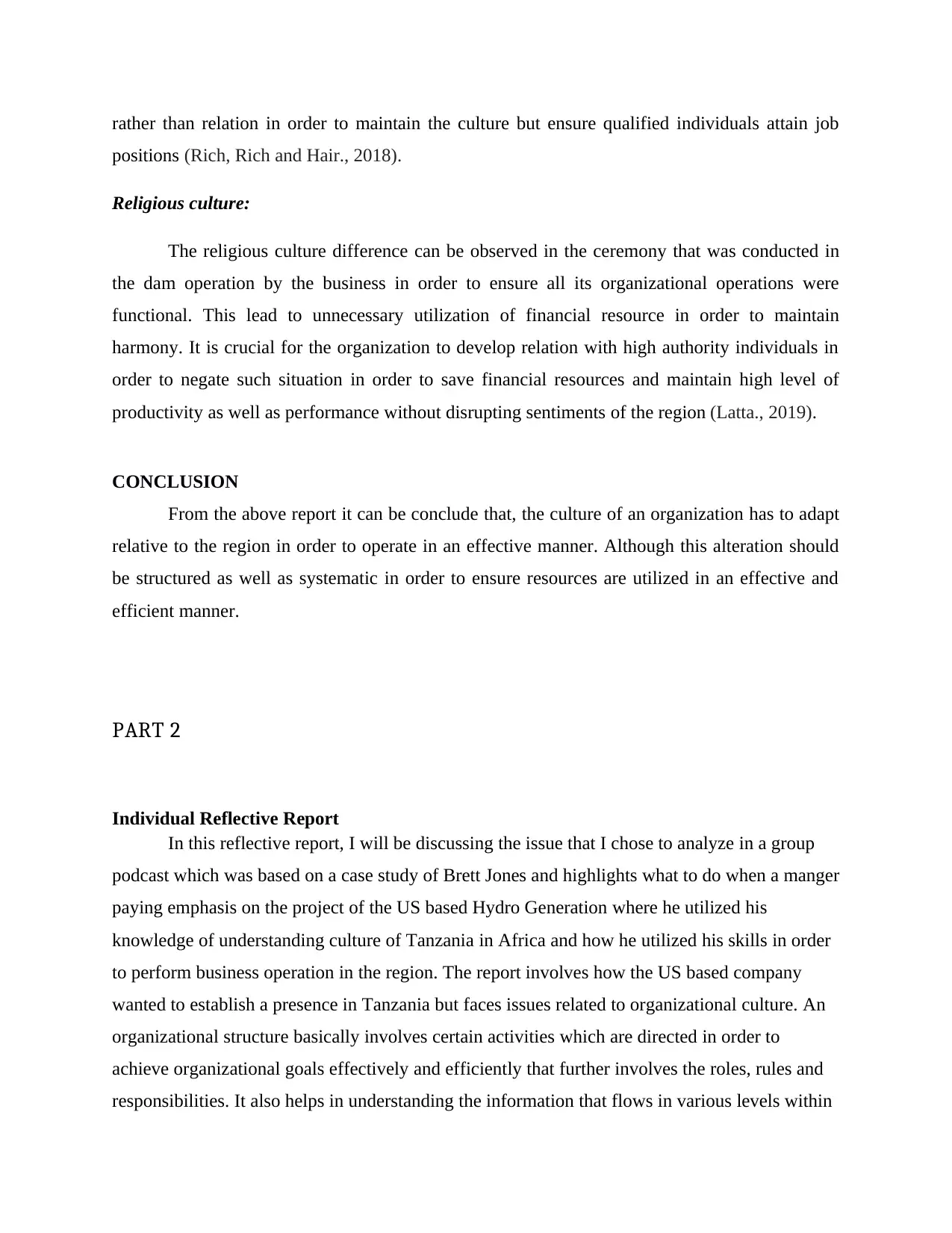
rather than relation in order to maintain the culture but ensure qualified individuals attain job
positions (Rich, Rich and Hair., 2018).
Religious culture:
The religious culture difference can be observed in the ceremony that was conducted in
the dam operation by the business in order to ensure all its organizational operations were
functional. This lead to unnecessary utilization of financial resource in order to maintain
harmony. It is crucial for the organization to develop relation with high authority individuals in
order to negate such situation in order to save financial resources and maintain high level of
productivity as well as performance without disrupting sentiments of the region (Latta., 2019).
CONCLUSION
From the above report it can be conclude that, the culture of an organization has to adapt
relative to the region in order to operate in an effective manner. Although this alteration should
be structured as well as systematic in order to ensure resources are utilized in an effective and
efficient manner.
PART 2
Individual Reflective Report
In this reflective report, I will be discussing the issue that I chose to analyze in a group
podcast which was based on a case study of Brett Jones and highlights what to do when a manger
paying emphasis on the project of the US based Hydro Generation where he utilized his
knowledge of understanding culture of Tanzania in Africa and how he utilized his skills in order
to perform business operation in the region. The report involves how the US based company
wanted to establish a presence in Tanzania but faces issues related to organizational culture. An
organizational structure basically involves certain activities which are directed in order to
achieve organizational goals effectively and efficiently that further involves the roles, rules and
responsibilities. It also helps in understanding the information that flows in various levels within
positions (Rich, Rich and Hair., 2018).
Religious culture:
The religious culture difference can be observed in the ceremony that was conducted in
the dam operation by the business in order to ensure all its organizational operations were
functional. This lead to unnecessary utilization of financial resource in order to maintain
harmony. It is crucial for the organization to develop relation with high authority individuals in
order to negate such situation in order to save financial resources and maintain high level of
productivity as well as performance without disrupting sentiments of the region (Latta., 2019).
CONCLUSION
From the above report it can be conclude that, the culture of an organization has to adapt
relative to the region in order to operate in an effective manner. Although this alteration should
be structured as well as systematic in order to ensure resources are utilized in an effective and
efficient manner.
PART 2
Individual Reflective Report
In this reflective report, I will be discussing the issue that I chose to analyze in a group
podcast which was based on a case study of Brett Jones and highlights what to do when a manger
paying emphasis on the project of the US based Hydro Generation where he utilized his
knowledge of understanding culture of Tanzania in Africa and how he utilized his skills in order
to perform business operation in the region. The report involves how the US based company
wanted to establish a presence in Tanzania but faces issues related to organizational culture. An
organizational structure basically involves certain activities which are directed in order to
achieve organizational goals effectively and efficiently that further involves the roles, rules and
responsibilities. It also helps in understanding the information that flows in various levels within
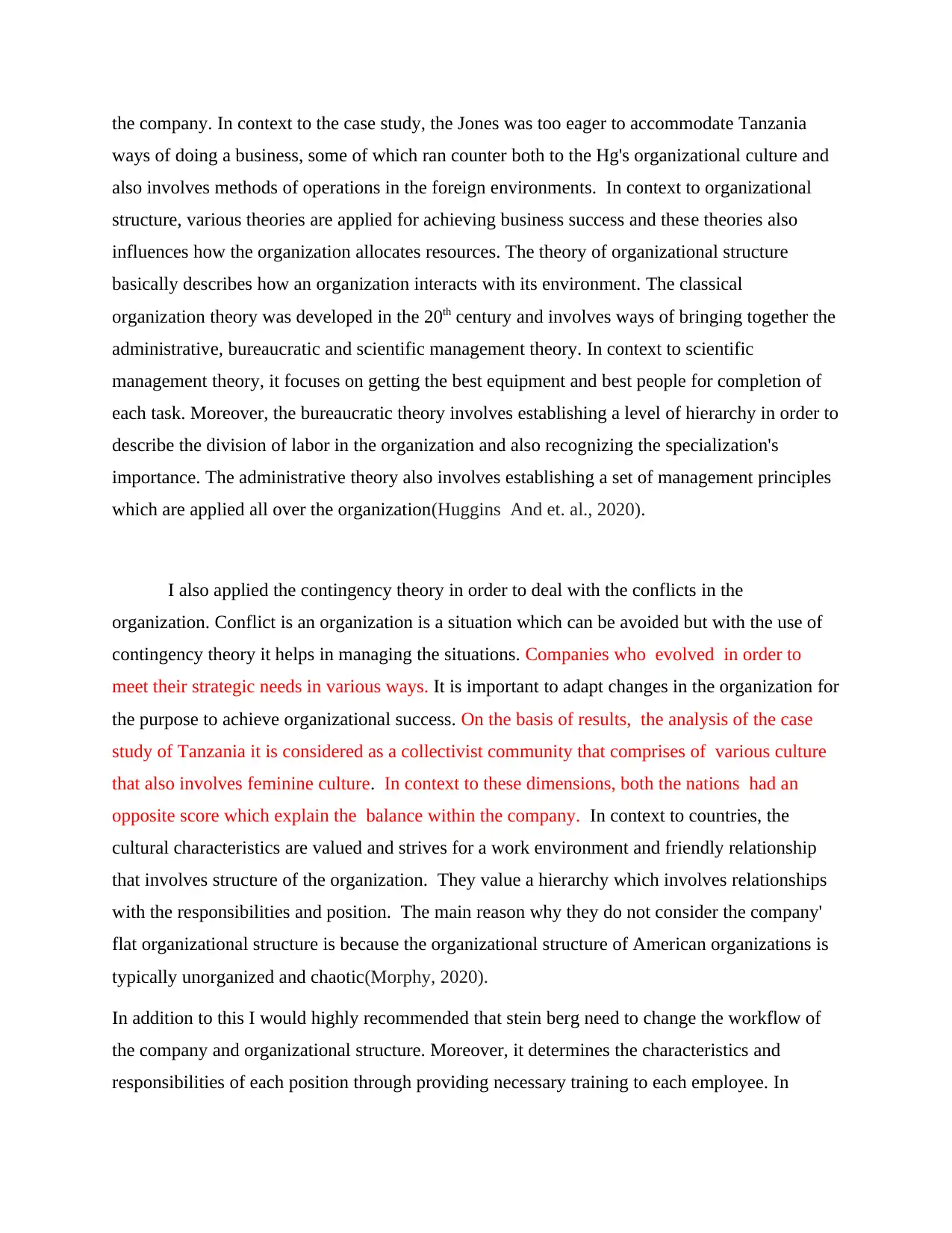
the company. In context to the case study, the Jones was too eager to accommodate Tanzania
ways of doing a business, some of which ran counter both to the Hg's organizational culture and
also involves methods of operations in the foreign environments. In context to organizational
structure, various theories are applied for achieving business success and these theories also
influences how the organization allocates resources. The theory of organizational structure
basically describes how an organization interacts with its environment. The classical
organization theory was developed in the 20th century and involves ways of bringing together the
administrative, bureaucratic and scientific management theory. In context to scientific
management theory, it focuses on getting the best equipment and best people for completion of
each task. Moreover, the bureaucratic theory involves establishing a level of hierarchy in order to
describe the division of labor in the organization and also recognizing the specialization's
importance. The administrative theory also involves establishing a set of management principles
which are applied all over the organization(Huggins And et. al., 2020).
I also applied the contingency theory in order to deal with the conflicts in the
organization. Conflict is an organization is a situation which can be avoided but with the use of
contingency theory it helps in managing the situations. Companies who evolved in order to
meet their strategic needs in various ways. It is important to adapt changes in the organization for
the purpose to achieve organizational success. On the basis of results, the analysis of the case
study of Tanzania it is considered as a collectivist community that comprises of various culture
that also involves feminine culture. In context to these dimensions, both the nations had an
opposite score which explain the balance within the company. In context to countries, the
cultural characteristics are valued and strives for a work environment and friendly relationship
that involves structure of the organization. They value a hierarchy which involves relationships
with the responsibilities and position. The main reason why they do not consider the company'
flat organizational structure is because the organizational structure of American organizations is
typically unorganized and chaotic(Morphy, 2020).
In addition to this I would highly recommended that stein berg need to change the workflow of
the company and organizational structure. Moreover, it determines the characteristics and
responsibilities of each position through providing necessary training to each employee. In
ways of doing a business, some of which ran counter both to the Hg's organizational culture and
also involves methods of operations in the foreign environments. In context to organizational
structure, various theories are applied for achieving business success and these theories also
influences how the organization allocates resources. The theory of organizational structure
basically describes how an organization interacts with its environment. The classical
organization theory was developed in the 20th century and involves ways of bringing together the
administrative, bureaucratic and scientific management theory. In context to scientific
management theory, it focuses on getting the best equipment and best people for completion of
each task. Moreover, the bureaucratic theory involves establishing a level of hierarchy in order to
describe the division of labor in the organization and also recognizing the specialization's
importance. The administrative theory also involves establishing a set of management principles
which are applied all over the organization(Huggins And et. al., 2020).
I also applied the contingency theory in order to deal with the conflicts in the
organization. Conflict is an organization is a situation which can be avoided but with the use of
contingency theory it helps in managing the situations. Companies who evolved in order to
meet their strategic needs in various ways. It is important to adapt changes in the organization for
the purpose to achieve organizational success. On the basis of results, the analysis of the case
study of Tanzania it is considered as a collectivist community that comprises of various culture
that also involves feminine culture. In context to these dimensions, both the nations had an
opposite score which explain the balance within the company. In context to countries, the
cultural characteristics are valued and strives for a work environment and friendly relationship
that involves structure of the organization. They value a hierarchy which involves relationships
with the responsibilities and position. The main reason why they do not consider the company'
flat organizational structure is because the organizational structure of American organizations is
typically unorganized and chaotic(Morphy, 2020).
In addition to this I would highly recommended that stein berg need to change the workflow of
the company and organizational structure. Moreover, it determines the characteristics and
responsibilities of each position through providing necessary training to each employee. In
⊘ This is a preview!⊘
Do you want full access?
Subscribe today to unlock all pages.

Trusted by 1+ million students worldwide
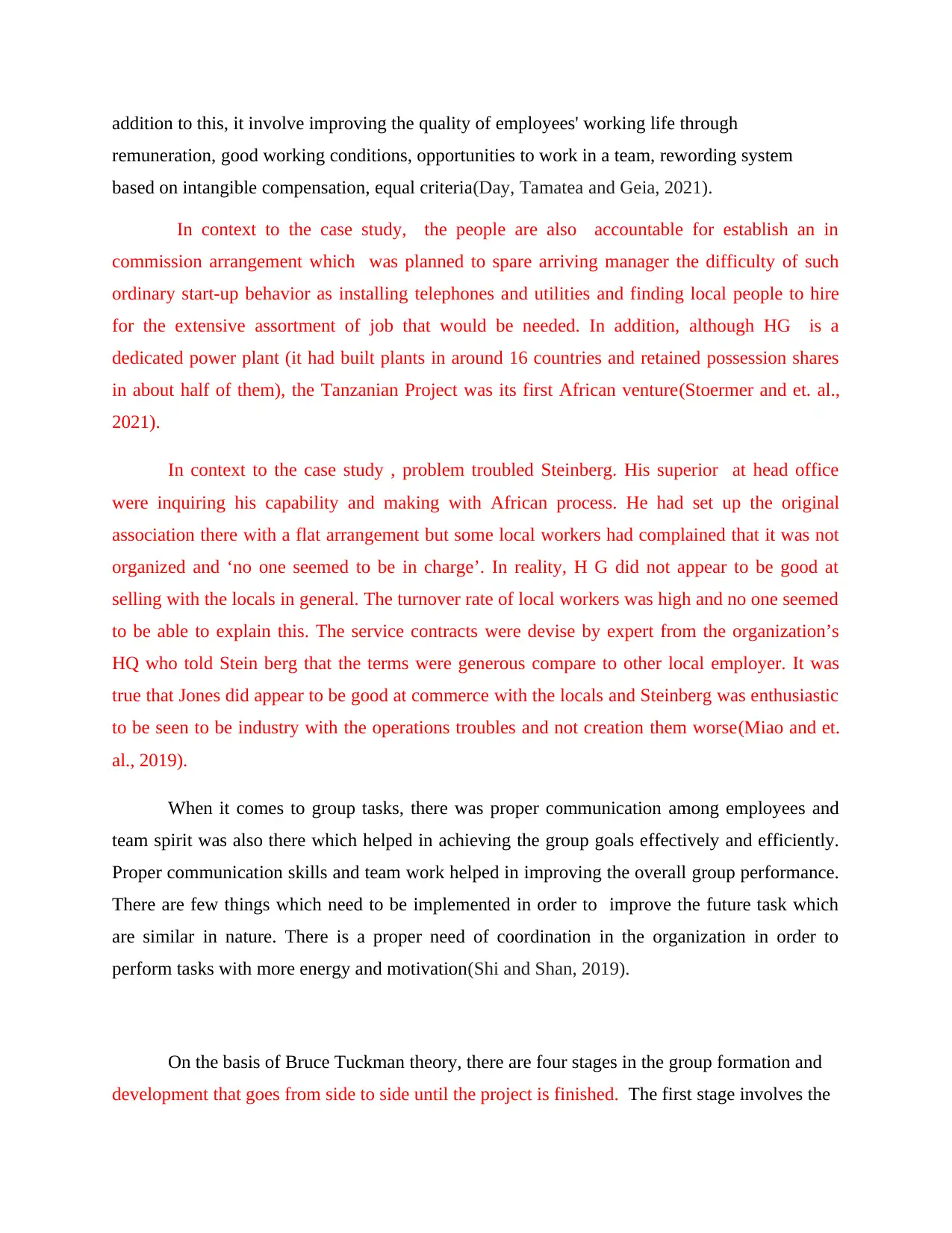
addition to this, it involve improving the quality of employees' working life through
remuneration, good working conditions, opportunities to work in a team, rewording system
based on intangible compensation, equal criteria(Day, Tamatea and Geia, 2021).
In context to the case study, the people are also accountable for establish an in
commission arrangement which was planned to spare arriving manager the difficulty of such
ordinary start-up behavior as installing telephones and utilities and finding local people to hire
for the extensive assortment of job that would be needed. In addition, although HG is a
dedicated power plant (it had built plants in around 16 countries and retained possession shares
in about half of them), the Tanzanian Project was its first African venture(Stoermer and et. al.,
2021).
In context to the case study , problem troubled Steinberg. His superior at head office
were inquiring his capability and making with African process. He had set up the original
association there with a flat arrangement but some local workers had complained that it was not
organized and ‘no one seemed to be in charge’. In reality, H G did not appear to be good at
selling with the locals in general. The turnover rate of local workers was high and no one seemed
to be able to explain this. The service contracts were devise by expert from the organization’s
HQ who told Stein berg that the terms were generous compare to other local employer. It was
true that Jones did appear to be good at commerce with the locals and Steinberg was enthusiastic
to be seen to be industry with the operations troubles and not creation them worse(Miao and et.
al., 2019).
When it comes to group tasks, there was proper communication among employees and
team spirit was also there which helped in achieving the group goals effectively and efficiently.
Proper communication skills and team work helped in improving the overall group performance.
There are few things which need to be implemented in order to improve the future task which
are similar in nature. There is a proper need of coordination in the organization in order to
perform tasks with more energy and motivation(Shi and Shan, 2019).
On the basis of Bruce Tuckman theory, there are four stages in the group formation and
development that goes from side to side until the project is finished. The first stage involves the
remuneration, good working conditions, opportunities to work in a team, rewording system
based on intangible compensation, equal criteria(Day, Tamatea and Geia, 2021).
In context to the case study, the people are also accountable for establish an in
commission arrangement which was planned to spare arriving manager the difficulty of such
ordinary start-up behavior as installing telephones and utilities and finding local people to hire
for the extensive assortment of job that would be needed. In addition, although HG is a
dedicated power plant (it had built plants in around 16 countries and retained possession shares
in about half of them), the Tanzanian Project was its first African venture(Stoermer and et. al.,
2021).
In context to the case study , problem troubled Steinberg. His superior at head office
were inquiring his capability and making with African process. He had set up the original
association there with a flat arrangement but some local workers had complained that it was not
organized and ‘no one seemed to be in charge’. In reality, H G did not appear to be good at
selling with the locals in general. The turnover rate of local workers was high and no one seemed
to be able to explain this. The service contracts were devise by expert from the organization’s
HQ who told Stein berg that the terms were generous compare to other local employer. It was
true that Jones did appear to be good at commerce with the locals and Steinberg was enthusiastic
to be seen to be industry with the operations troubles and not creation them worse(Miao and et.
al., 2019).
When it comes to group tasks, there was proper communication among employees and
team spirit was also there which helped in achieving the group goals effectively and efficiently.
Proper communication skills and team work helped in improving the overall group performance.
There are few things which need to be implemented in order to improve the future task which
are similar in nature. There is a proper need of coordination in the organization in order to
perform tasks with more energy and motivation(Shi and Shan, 2019).
On the basis of Bruce Tuckman theory, there are four stages in the group formation and
development that goes from side to side until the project is finished. The first stage involves the
Paraphrase This Document
Need a fresh take? Get an instant paraphrase of this document with our AI Paraphraser
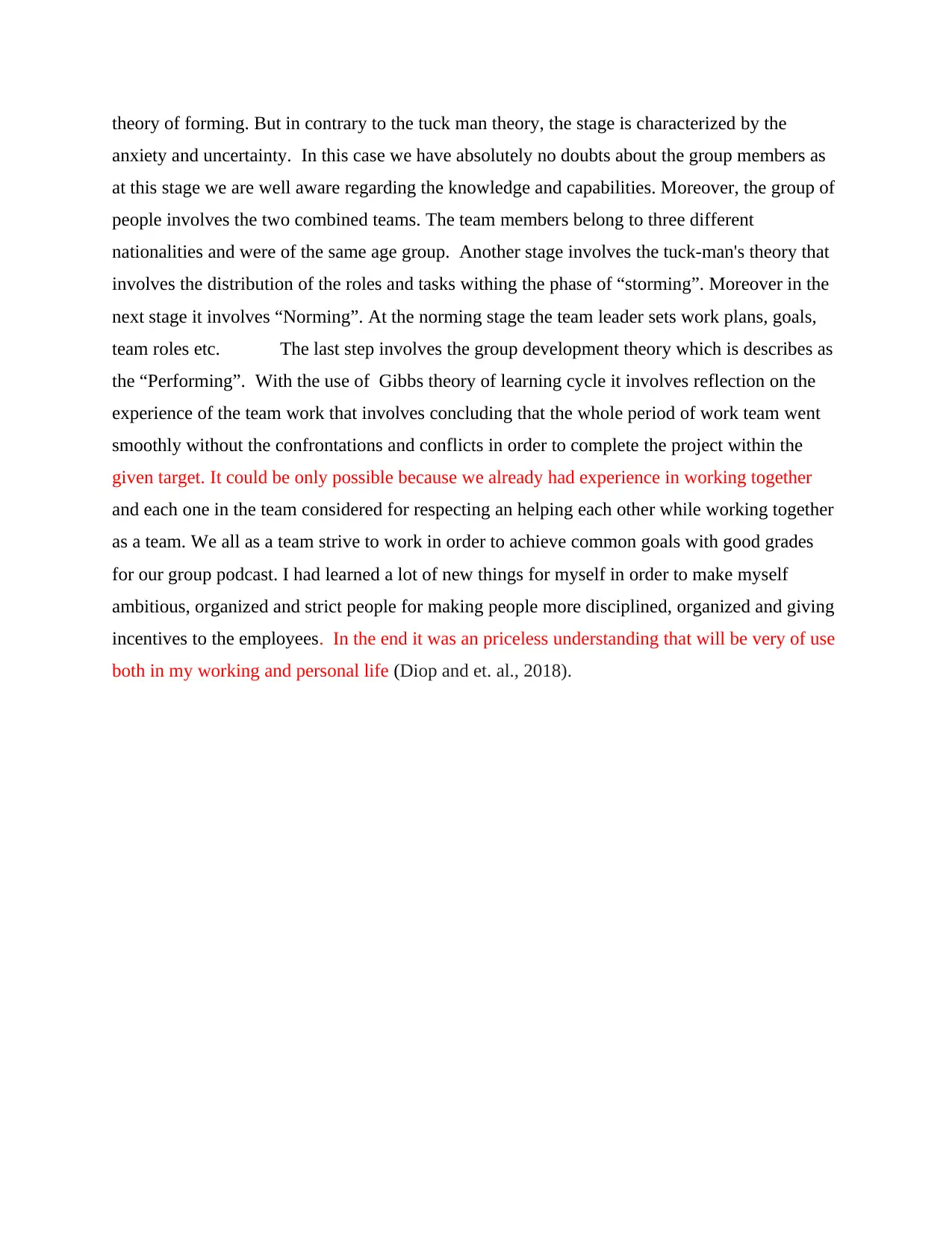
theory of forming. But in contrary to the tuck man theory, the stage is characterized by the
anxiety and uncertainty. In this case we have absolutely no doubts about the group members as
at this stage we are well aware regarding the knowledge and capabilities. Moreover, the group of
people involves the two combined teams. The team members belong to three different
nationalities and were of the same age group. Another stage involves the tuck-man's theory that
involves the distribution of the roles and tasks withing the phase of “storming”. Moreover in the
next stage it involves “Norming”. At the norming stage the team leader sets work plans, goals,
team roles etc. The last step involves the group development theory which is describes as
the “Performing”. With the use of Gibbs theory of learning cycle it involves reflection on the
experience of the team work that involves concluding that the whole period of work team went
smoothly without the confrontations and conflicts in order to complete the project within the
given target. It could be only possible because we already had experience in working together
and each one in the team considered for respecting an helping each other while working together
as a team. We all as a team strive to work in order to achieve common goals with good grades
for our group podcast. I had learned a lot of new things for myself in order to make myself
ambitious, organized and strict people for making people more disciplined, organized and giving
incentives to the employees. In the end it was an priceless understanding that will be very of use
both in my working and personal life (Diop and et. al., 2018).
anxiety and uncertainty. In this case we have absolutely no doubts about the group members as
at this stage we are well aware regarding the knowledge and capabilities. Moreover, the group of
people involves the two combined teams. The team members belong to three different
nationalities and were of the same age group. Another stage involves the tuck-man's theory that
involves the distribution of the roles and tasks withing the phase of “storming”. Moreover in the
next stage it involves “Norming”. At the norming stage the team leader sets work plans, goals,
team roles etc. The last step involves the group development theory which is describes as
the “Performing”. With the use of Gibbs theory of learning cycle it involves reflection on the
experience of the team work that involves concluding that the whole period of work team went
smoothly without the confrontations and conflicts in order to complete the project within the
given target. It could be only possible because we already had experience in working together
and each one in the team considered for respecting an helping each other while working together
as a team. We all as a team strive to work in order to achieve common goals with good grades
for our group podcast. I had learned a lot of new things for myself in order to make myself
ambitious, organized and strict people for making people more disciplined, organized and giving
incentives to the employees. In the end it was an priceless understanding that will be very of use
both in my working and personal life (Diop and et. al., 2018).
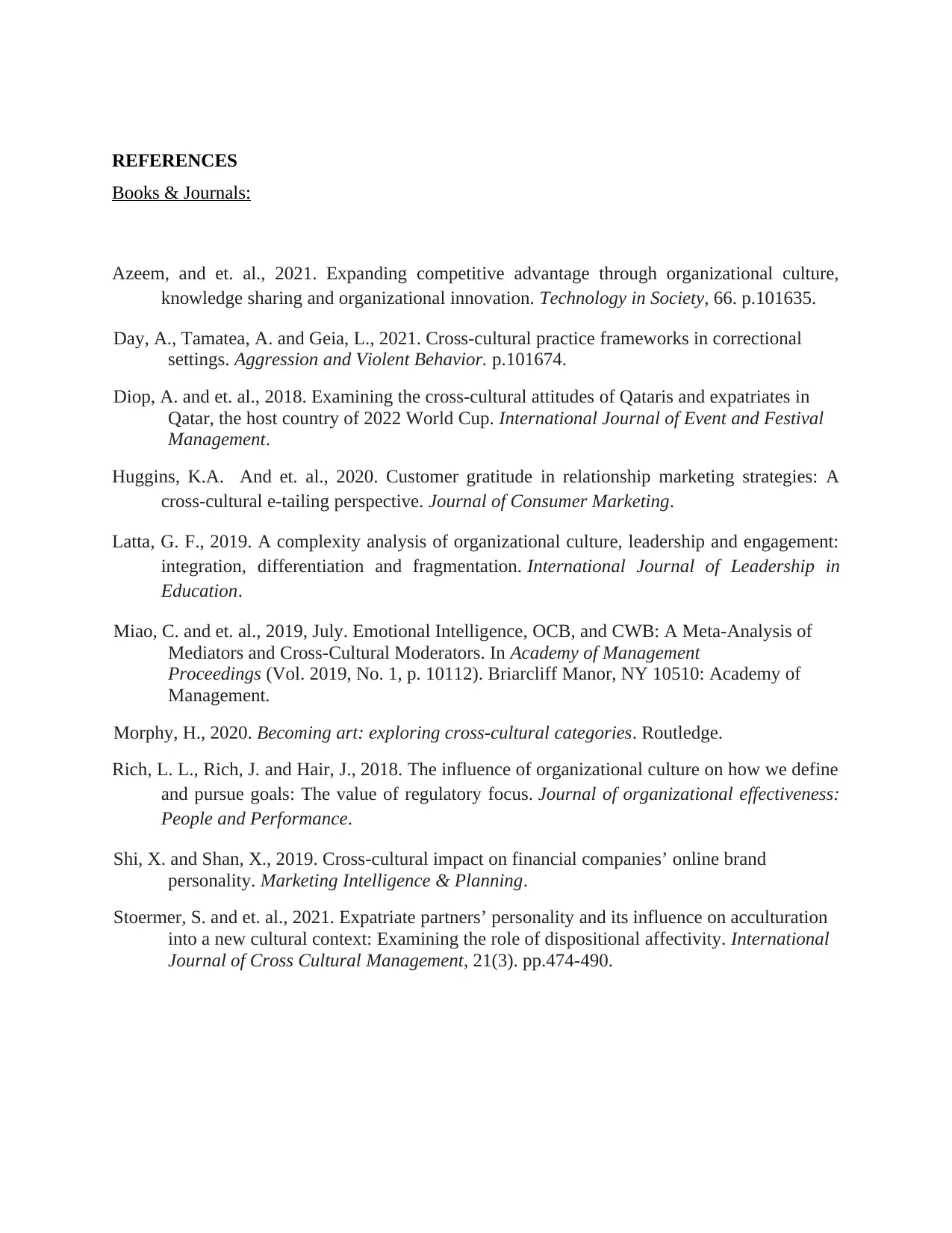
REFERENCES
Books & Journals:
Azeem, and et. al., 2021. Expanding competitive advantage through organizational culture,
knowledge sharing and organizational innovation. Technology in Society, 66. p.101635.
Day, A., Tamatea, A. and Geia, L., 2021. Cross-cultural practice frameworks in correctional
settings. Aggression and Violent Behavior. p.101674.
Diop, A. and et. al., 2018. Examining the cross-cultural attitudes of Qataris and expatriates in
Qatar, the host country of 2022 World Cup. International Journal of Event and Festival
Management.
Huggins, K.A. And et. al., 2020. Customer gratitude in relationship marketing strategies: A
cross-cultural e-tailing perspective. Journal of Consumer Marketing.
Latta, G. F., 2019. A complexity analysis of organizational culture, leadership and engagement:
integration, differentiation and fragmentation. International Journal of Leadership in
Education.
Miao, C. and et. al., 2019, July. Emotional Intelligence, OCB, and CWB: A Meta-Analysis of
Mediators and Cross-Cultural Moderators. In Academy of Management
Proceedings (Vol. 2019, No. 1, p. 10112). Briarcliff Manor, NY 10510: Academy of
Management.
Morphy, H., 2020. Becoming art: exploring cross-cultural categories. Routledge.
Rich, L. L., Rich, J. and Hair, J., 2018. The influence of organizational culture on how we define
and pursue goals: The value of regulatory focus. Journal of organizational effectiveness:
People and Performance.
Shi, X. and Shan, X., 2019. Cross-cultural impact on financial companies’ online brand
personality. Marketing Intelligence & Planning.
Stoermer, S. and et. al., 2021. Expatriate partners’ personality and its influence on acculturation
into a new cultural context: Examining the role of dispositional affectivity. International
Journal of Cross Cultural Management, 21(3). pp.474-490.
Books & Journals:
Azeem, and et. al., 2021. Expanding competitive advantage through organizational culture,
knowledge sharing and organizational innovation. Technology in Society, 66. p.101635.
Day, A., Tamatea, A. and Geia, L., 2021. Cross-cultural practice frameworks in correctional
settings. Aggression and Violent Behavior. p.101674.
Diop, A. and et. al., 2018. Examining the cross-cultural attitudes of Qataris and expatriates in
Qatar, the host country of 2022 World Cup. International Journal of Event and Festival
Management.
Huggins, K.A. And et. al., 2020. Customer gratitude in relationship marketing strategies: A
cross-cultural e-tailing perspective. Journal of Consumer Marketing.
Latta, G. F., 2019. A complexity analysis of organizational culture, leadership and engagement:
integration, differentiation and fragmentation. International Journal of Leadership in
Education.
Miao, C. and et. al., 2019, July. Emotional Intelligence, OCB, and CWB: A Meta-Analysis of
Mediators and Cross-Cultural Moderators. In Academy of Management
Proceedings (Vol. 2019, No. 1, p. 10112). Briarcliff Manor, NY 10510: Academy of
Management.
Morphy, H., 2020. Becoming art: exploring cross-cultural categories. Routledge.
Rich, L. L., Rich, J. and Hair, J., 2018. The influence of organizational culture on how we define
and pursue goals: The value of regulatory focus. Journal of organizational effectiveness:
People and Performance.
Shi, X. and Shan, X., 2019. Cross-cultural impact on financial companies’ online brand
personality. Marketing Intelligence & Planning.
Stoermer, S. and et. al., 2021. Expatriate partners’ personality and its influence on acculturation
into a new cultural context: Examining the role of dispositional affectivity. International
Journal of Cross Cultural Management, 21(3). pp.474-490.
⊘ This is a preview!⊘
Do you want full access?
Subscribe today to unlock all pages.

Trusted by 1+ million students worldwide
1 out of 9
Related Documents
Your All-in-One AI-Powered Toolkit for Academic Success.
+13062052269
info@desklib.com
Available 24*7 on WhatsApp / Email
![[object Object]](/_next/static/media/star-bottom.7253800d.svg)
Unlock your academic potential
Copyright © 2020–2025 A2Z Services. All Rights Reserved. Developed and managed by ZUCOL.



